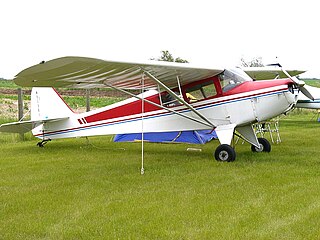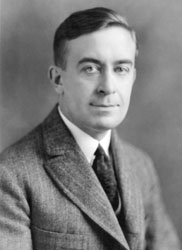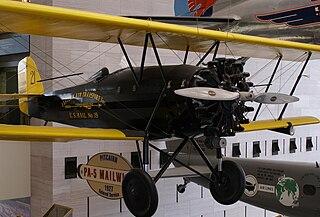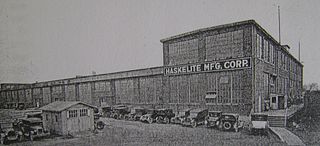
The Cessna Aircraft Company was an American general aviation aircraft manufacturing corporation headquartered in Wichita, Kansas. Cessna produced small, piston-powered aircraft, as well as business jets. For many years the company was one of the highest-volume producers of general aviation aircraft in the world. The company was founded in 1927. It was purchased by General Dynamics in 1985, then by Textron, Inc., in 1992. In March 2014, when Textron purchased the Beechcraft and Hawker Aircraft businesses, Cessna ceased operations as a subsidiary company and joined the others as one of the three distinct brands produced by Textron Aviation.

Blackburn Aircraft Limited was a British aircraft manufacturer that concentrated mainly on naval and maritime aircraft during the first part of the 20th century.
The Curtiss-Wright Corporation is an American, global diversified product manufacturer and service provider, incorporated in Delaware with headquarters in Parsippany-Troy Hills, New Jersey, which supplies the commercial, industrial, defense, and energy markets. Created in 1929 from the consolidation of Curtiss, Wright, and various supplier companies, by the end of World War II it was the largest aircraft manufacturer in the United States, supplying whole aircraft in large numbers to the U.S. Armed Forces. It has since evolved away from final assembly of finished aircraft, becoming a component manufacturer specializing in actuators, aircraft controls, valves, and surface-treatment services. It also is a supplier to commercial nuclear power, nuclear navy systems, industrial vehicles and to the oil and gas industries. It has an integrated supply chain and an extensive worldwide service network, and is one of the largest diversified market players in the aerospace sector.

The Republic Aviation Corporation was an American aircraft manufacturer based in Farmingdale, New York, on Long Island. Originally known as the Seversky Aircraft Company, the company was responsible for the design and production of many important military aircraft, including its most famous products: World War II's P-47 Thunderbolt fighter, the F-84 Thunderjet and F-105 Thunderchief jet fighters, as well as the A-10 Thunderbolt II close-support aircraft.
The Lockheed Model 10 Electra is an American twin-engined, all-metal monoplane airliner developed by the Lockheed Aircraft Corporation in the 1930s to compete with the Boeing 247 and Douglas DC-2. The type gained considerable fame as one was flown by Amelia Earhart on her ill-fated around-the-world expedition in 1937.

The Monocoupe 90 was a two-seat, light cabin airplane built by Donald A. Luscombe for Monocoupe Aircraft. The first Monocoupe was built in an abandoned church in Davenport, Iowa, and first flew on April 1, 1927. Various models were in production until the late 1940s.

The Vultee Aircraft Corporation became an independent company in 1939 in Los Angeles County, California. It had limited success before merging with the Consolidated Aircraft Corporation in 1943, to form the Consolidated Vultee Aircraft Corporation − or Convair.

Taylorcraft Aviation is an airplane manufacturer that has been producing aircraft for more than 70 years in several locations.

The de Havilland DH.91 Albatross was a four-engine British transport aircraft in the 1930s. A total of seven aircraft were built in 1938–39.
Avco Corporation is a subsidiary of Textron which operates Textron Systems Corporation and Lycoming.

William Bushnell Stout was a pioneering American inventor, engineer, developer and designer whose works in the automotive and aviation fields were groundbreaking. Known by the nickname "Bill", Stout designed an aircraft that eventually became the Ford Trimotor and was an executive at the Ford Motor Company.
The Seaplane Experimental Station, formerly RNAS Felixstowe, was a British aircraft design unit during the early part of the 20th century.

Alfred Victor Verville was an aviation pioneer and aircraft designer who contributed to civilian and military aviation. During his forty-seven years in the aviation industry, he was responsible for the design and development of nearly twenty commercial and military airplanes. Verville is known for designing flying boats, military racing airplanes, and a series of commercial cabin airplanes. His planes were awarded with the Pulitzer Speed Classic Trophy in 1920 and 1924.

The Pitcairn Aircraft Company was an American aircraft manufacturer of light utility aircraft. An early proponent of the autogyro, the company, later known as the Autogiro Company of America among other names, remained in business until 1948.

Assen "Jerry" Jordanoff born Asen Hristov Yordanov, September 2, 1896, Sofia, Bulgaria – d. October 19, 1967, White Plains, New York) was a Bulgarian inventor, engineer, and aviator. Jordanoff is considered to be the founder of aeronautical engineering in Bulgaria, as well as a contributor to the development of aviation in the United States.

Vance Breese (1904–1973) was an American aviation engineer and test pilot.
The Hise Model A was a trimotor aircraft built by the Hise Aircraft Corporation, founded by Detroit, Michigan industrialist Fred Hise. The Vice President of the company, E.L. Inlow, announced that a manufacturing facility was planned for Pontiac, Michigan within a few months of August, 1929. The prototype was shown at the 1929 National Aeronautic Exposition, held at Cleveland from August 24 to September 2, 1929. On March 17, 1930, the company entered into a contract with the Dixie and Northern Air Line for the purchase of 5 aircraft, with the first of the planes to be delivered on or before August 5, 1930. The airline was organized to provide passenger service between Detroit and Miami, at the time one of the longest routes in the United States. However, the planned $100,000 sale was never completed after the airline's authorization to issue stock was revoked by the Michigan Public Utilities Commission when it objected to the airline's plans to spend all of the stock sale proceeds on the new aircraft, leaving nothing for operations.

Haskelite Manufacturing Corporation (1917–1956) was a conglomerate of Michigan–based companies. It was located on Broadway Avenue in Grand Rapids, Michigan. They manufactured haskelite plywood for a wide variety of applications and vehicles. Their office headquarters were located in Chicago, Illinois. The Grand Rapids corporation was a spin-off from the Haskell Manufacturing Company in Ludington, Michigan. It was a factory twice the capacity at over 100,000 square feet and designed to make up to ten times as much plywood per day as the Ludington facilities. The plywood at the beginning was needed for World War I military airplane body parts. The plywood later was used in houses, buildings, automobiles and ship construction. Different styles and types of plywood were made for particular niches. The corporation made the largest plywood ever produced, which was used in constructing a particular US Navy boat. A well known use for the Haskelite plywood produced at the Grand Rapids facilities was for the construction of the Spirit of St. Louis, Charles Lindberg's plane.

William Wallace Kellett was an American aircraft executive and manufacturer, especially associated with rotary-wing aircraft. He was president of Kellett Autogiro Corporation and Republic Aviation Corporation. His company constructed the first successful wingless aircraft in the United States.
Dwane Leon Wallace was an American aviation businessman and aircraft designer. He served as the President and/or chairman of the board of the Cessna Aircraft Company from 1935 until the 1970s, having then continued on the board as a director and consultant into the 1980s. He is generally credited with leading the company from a minor role in the aviation industry to overwhelming dominance—ultimately the world's largest and most diverse general aviation manufacturer with the highest volume of aircraft production. Wallace later became known as the "Quiet Giant of Aviation", and was posthumously inducted into the National Aviation Hall of Fame in 2012. He was included in the Flying Magazine list of the "51 Heroes of Aviation", placing at number 11.














